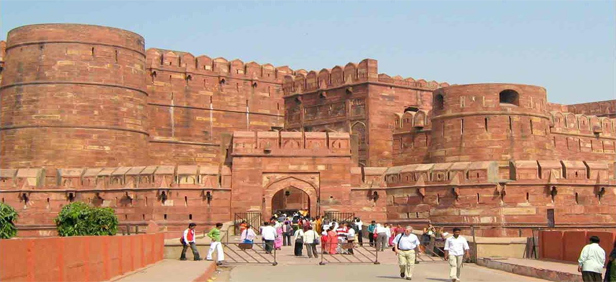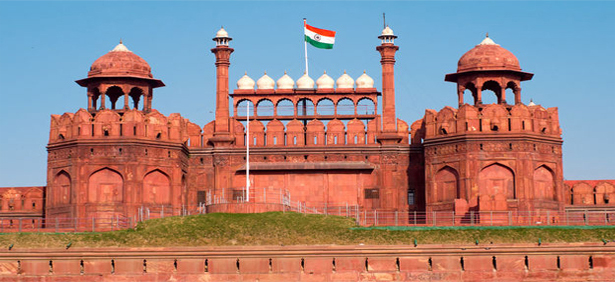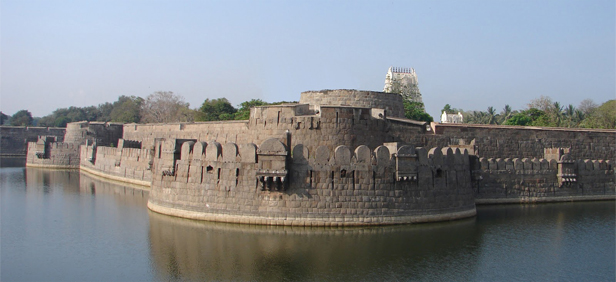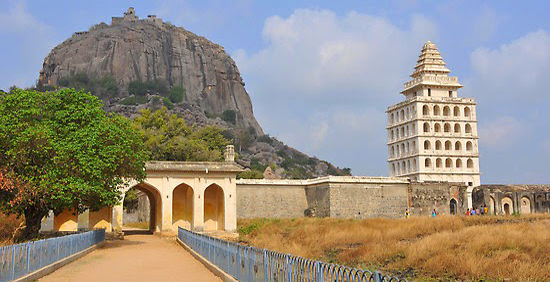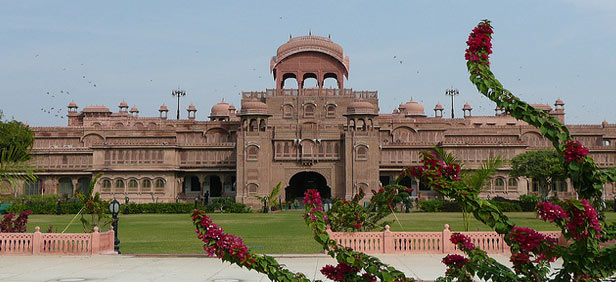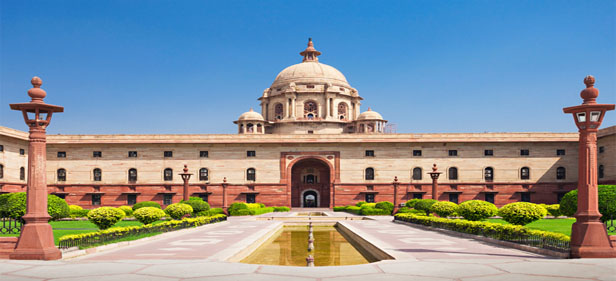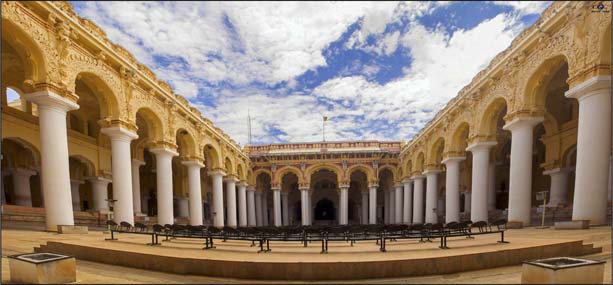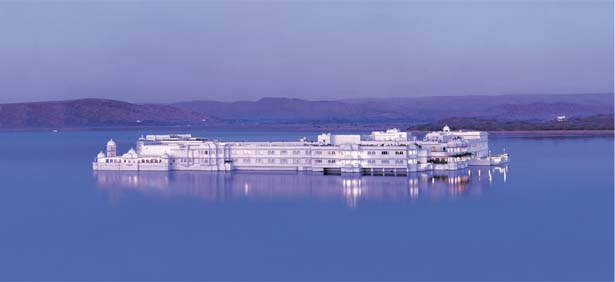1902-1926 and named after his father Maharaja Lall Singh - Designed by Sir Samuel Swinton Jacob - Houses a museum, library, the Royal Family's House, and couple of Star Hotels.
4) ROYAL PALACE - Fatehpur Sikri: Built by Akbar in 1570 - The palace comprises of the following architectural monuments - Buland Darwaza, Jama Masjid, Tomb of Salim Chisti, Diwan i Am, Diwan i Khas, Ibadat Khana, Mariam Uz Zamani Palace,Naubhat Khana, Panch Mahal etc., A world Heritage Site.
5) PURANI HAVELI - Hyderabad, AP: It was the official residence of Nizam of Hyderabad. It was built by Ali Khan Bahadur Asaf Jah II during 1880s. It now houses the Nizam's museum, a school and an Industrial Training Institute.
6) CHOWMAHALLA PALACE - Hyderabad, AP: Built between 1857-1869 by Afzal ad Dawlah Asaf Jah V - it was the official residence of the Nizams of Hyderabad.
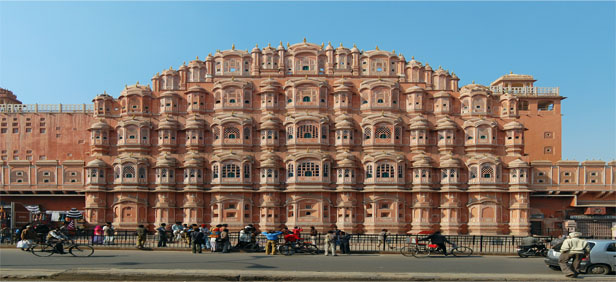
7) FALAKNUMA PALACE - Hyderabad, AP: built by Nawab Vikar ul Umra, PM of Nizam of Hyderabad - now houses the Taj Group of Hotels.
8) HAWA MAHAL - Jaipur, Rajasthan: "Palace of Winds" built with Red and Pink sand stones by Maharaja Sawai Pratap Singh in 1799 - designed in the form of the crown of Lord Krishna - has 953 windows.
9) RAMBAGH PALACE - Jaipur, Rajasthan: The constructions began around 1887 and was completed in 1931 by Maharajah Sawai Man Singh II around 1931. Now houses one of the world's best star hotel run by the Taj Groups. (Hotel Taj Palace).10) Samsode Palace - Jaipur, Rajasthan: 16th century - by the Maha Rawal or Maha Sahebs, noble feudatories of Amber and Jaipur principality.
11) RAJMAHAL PALACE - Jaipur, Rajasthan: Formerly a royal residence and now a hotel.
12) NARAIN NIWAS PALACE - Jaipur, Rajasthan: Formerly the residence of the Thakur (landed noble) of Kanota - now a Hotel.
13) UMAID BHAWAN PALACE - Jodhpur, Rajasthan: Built between 1929-1943 by Maharaja Umaid Singh - one of the largest palaces - has 347 rooms - Now a Star Hotel, a museum and the royal residence of the owners.
14) LAKSHMIPURAM PALACE - Changanacherry, Kerala: It was the seat of the royal family of Koi Thampurans of Kerala.
15) NEDUMPURAM PALACE - Tiruvalla, Kerala:
16) MYSORE PALACE - Mysore, Karnataka.:Built between 1897-1912 by Krishnaraja Wodeyar IV - The palace was designed by British architect Henry Irwin. (The earlier palace built in 1803, was destroyed in a fire accident in 1897) Dussehra Festival is the major attraction in this palace.
17) PADMANABHAPURAM PALACE - Trivandrum, Kerala.: Built in 1601 by Iravi Varma Kulasekara Perumal. The entire palace land is surrounded by Tamilnadu, but belongs to Kerala. The palace has a 300 year old clock tower, which still maintains time.
18) AMAR MAHAL PALACE - Jammu, Kashmir.: Built during the 19th century by Raja Amar Singh, a Dogra King. Now a museum.
19) JAGAN MOHANA PALACE - Mysore, Karnataka. Built in 1861 by Krishnaraja Wodeyar III - used as a Royal House. Now an Art Gallery.
20) KILIMANOOR PALACE .: Built in 1753 - The famous Kerala ruler Raja Ravi Varma was born here. Now the descendants of the royal family live here.
21) MONSOON PALACE - Udaipur, Rajasthan: Earlier known as Sajjangarh Palace.Was built by Maharaja Sajjan Singh of the Mewar Dynasty in 1884. Located on a hilltop on the Aravalli ranges in front of the Pichola lake. It is surrounded by a Sanctuary. A definite place of attraction.
22) DUTCH PALACE- Mattancherry, Kerala.: Built by Portuguese and presented to Veera Kerala Varma in 1555 AD.
23) RAJENDRA VILAS PALACE - Mysore, Karnataka. It was the earlier royal residence of the Wodeyear which got destroyed in a fire accident in 1897.
24) MARBLE PALACE - Kolkatta, WB: Built in 1835 by Raja Rajendra Mullick. Now his descendants are living here.
25) KUTHIRA MALIKA - Tiruvananthapuram - Kerala: Built during 1840s by Swati Tirunal Rama Varma - now part of it houses a museum - During January a Sangeethotsavam for Carnatic and Hindustani music festival is held here every here.
26) LEH PALACE - Leh, Ladakh:Built in the 17th century by King Sengge Namgyal -It is a now a mere tourist attraction with a museum housing some artifacts.
27) NEERMAHAL PALACE - Agartala, Tripura.: Built in 1930 by King Bikram Kishore Deb Barman - located in the middle of Rudra Sagar lake. It is the second such palace in India which is inside a lake.
28) MOTI SHAHI PALACE - Ahmedabad, Gujarat: Built between 1618-1622 by Shah Jahan when he was the Governor of Suba. It now houses the Sardar Vallabhai Patel Museum.
29) TIRUMALAI NAYAK MAHAL - Madurai, Tamil Nadu.Built in 1636 by Tirumalai Nayak of the Nayak Dynasty which ruled Madurai in Tamilnadu. It is now a tourist>
attraction.
30) UJJAYANTA PALACE - Agartala, Tripura - Built between 1899-1901 by Maharaja Radhakrishna Manikya - Now part the State Legislative Assembly.
31. LAKE PALACE: Udaipur - Located in the middle of Pichola Lake and built during 1743-1746 by the Maharaji then. Now a luxury hotel.
Q132. What is a palace and where from the word "Palace" derived?
An institution which collects, documents, artifacts, and preserves, exhibits and interprets material evidence and related information for the public.
Q133. Where is the "Lakshmi Vilas Palace" located, and it was built during the rule of ?
Located at Vadodara (Baroda), Gujarat - It was built in 1890 during the rule of Maharaja Sayaji Rao.
Q134. The Lakshmi Vilas Palace in Vadodara now houses?
Railway Staff College, for training its officers.
Q135. Where is Lalgarh Palace and when and who built it?
Bikaner, Rajasthan. Built by Rajput Maharaja Ganga Singh during 1902-1906.
Q136. Who designed the Lalgarh Palace?
Sir Swinton Jacob, a British architect.
Q137. The Lalgarh palace in Bikaner, Rajasthan now houses?
Part of the Palace now houses a star hotel by the Taj Welcome Group.
Q138. Where is the Rashtrapati Bhavan located?
Lutyens area of Delhi on the Raisina Hill.
Q139. When was the Rashtrapati Bhavan built?
In the second half of 1920s and completed in 1931.
Q140. Rashtrapati Bhavan was earlier known as?
Viceregal Lodge as it was occupied by the Viceroy of the British. In 1950, it was named as Rashtrapati Bhavan.
Q141. Who designed the Rashtrapati Bhavan?
British architect Edwin Lutyen and partly by South African architect Baker.
Q142. Of the Rashtrapati Bhavan, which is the famous room?
" Throne Room " the seat of the Viceroy. Now it is known as Darbar Hall.
Q143. What are the salient features of Rashtrapati Bhavan?
1. It is the biggest official residence of any Heads of State.
2. No steel was used in the construction.
3. It has more than 350 rooms.
Q144. Who was the first Indian to occupy the Rashtrapati Bhavan?
Sir C.Rajagopalachari, the first Indian Governor General.
Q145. How is the Rose Garden in Rashtrapati Bhavan called?
Mughal Garden
Q146. Who built the Royal Palace of Fatehpur Sikri?
It was the royal palace of Akbar built in honour of sufi saint Salim Chisti. It was the capital of Mughal Empire between 1571-1575. Now, it is a UNESCO declared World Heritage Site since 1986.
Q147. What is "Purani Haveli" a Palace and where is it?
It was the official residence of the Nizam of Hyderabad. It is an U shaped palace with two oblong wings running parallel to each other and the residential palace located perpendicular in the middle. A unique feature of this palace is the world's longest wardrobe built in two levels with a hard cranked wooden lift elevator in place.
Q148. Where is "Chowmahalla Palace" is located?
It is in Hyderabad. It was the seat of the Asaf Sahi Dynasty where the Nizam (Hyderabad) used to entertain his official guests. Constructed and completed in 1857, it is believed to be a replica of Shah of Iran's palace in Tehran.
Q149. Where is Falaknuma Palace?
It is in Hyderabad. Designed by an Italian architect, it is located on a hill of 650 mtr high. Built by Paigah Nawab Vikram VI Umra in the 1880 ( began in 1884). It was bought over by the Nizam of Hyderabad in 1897, and used as a Royal Guest House. It is completely built with Italian marble. The JADE (Gemstone) collection of the palace is unique in the world. The palace has the unique 100 scater dining table. The side walls are decorated with the portraits of all the guests stayed there. It is now housing a star hotel by the Taj group. The palace provides a panoramic view of the city of Hyderabad.
Q150. Where is "Hawa Mahal" Palace?
Jaipur - Rajasthan - Also called "Palace of Winds". Built by Maharaja Sawai Pratap Singh in 1799 with red and pink stones and has 5 stories. The side fasing the street has 953 small windows, which allows air to circulate and make it cooler even during summer. Thus it is gained this name.
Q151. Where is Rambagh Palace?
Also called the "Jewel of Jaipur". It was formerly, a hunting lodge of the Royal. It was converted into a palace in 1925 by Maharaja Sawai Mausingh II. Since 1972, it is now under the management of the Taj Group of Hotels.
Q152. Where is Samsode Palace?
Jaipur, Rajasthan - Built in the 19th century by Jaipur rulers is now a heritage hotel.
Q153. Where is Rajmahal Palace, Narain Niwas Palace?
Jaipur, Rajasthan - Built by Jaipur rulers in the 19th century, now a star hotel.
Q154. Where is "Umaid Bhawan Palace"? What are it's unique features?
Jodhpur, Rajasthan - Located on the Chattaar Hill, Jodhpur, Rajasthan. Built during 1930-40s. Maharaja Umed Singh laid the foundation in 1929. When it was completed, it was the largest private residence with 347 rooms spread across 26 acres. Now the palace divided into three houses, a Royal residence, Star Hotel, and a museum.
Q155. Where is Lakshmipuram Palace?
Situated in Changanacherry, Kerala, it was the royal palace of the Koil Thampoorans.
Q156. Where is Nedumpuram Palace?
Tiruvalla, Kerala. Belongs to a branch of the Kulasekhara Dynasty that ruled the principality of Udhayamangalam in the northern region of Kerala.
Q157. Where is Mysore Palace, when was it built, and what are it's special features?
Mysore, Karnataka. Commissioned in 1897 and completed in 1912. It was built/completed during the period of Queen Kempananjammanni Vanivilas Sannidhana. A major tourist attraction. The palace was designed the British Architect Henry Irwin and the architecture is Indo-Sarcenic combining Hindu, Muslim, Rajput & Gothic styles. The palace is the venue for the annual Dasara festival held in autumn (September - October) attracting huge crowds including foreigners. The palace houses Amba Vilasa (Private audience room), Gombe Thotti (Doll's Pavilion) and two temples Someshwara (Siva) and Lakshmiramana (Vishnu) and an Armoury.
Q158. Where is Padmanabhapuram Palace and what are it's features?
Padmanabhapuram, Tiruvanandapuram, Kerala: Lies about 63 km from Tiruvananthapuram on the route to Kanyakumari, Tamil Nadu. The palace lies inside an old granite fortress around 4 km long, and lies at the foot of the Velli Hills. It was built around 1601 by Ravi Varma Kulasekhara Perumal. It is the best example of Kerala architecture where the wood is given more prominence with beautiful carvings and support structures. The major features of the palace are: (1) The clock tower is 300 years old with the clock still keeping time; (2) The guest hall can accommodate 1000 guests; (3) A secret passage (now in disuse/blocked) for the royal people to escape in emergencies.
Q159. Where is Amar Mahal Palace?
Jammu, Kashmir built by Raja Amar Singh. The palace was designed in the French style - Chateau. It now houses a museum and library.
Q160. Where is Jagan Mohana Palace?
Mysore, Karnataka. Former palace of Maharaja of Mysore, now housing Art Gallery, Library and a music concert hall.
Q161. Where is Kilimanoor Palace? What is it's importance?
Kilimanoor, Kerala. Palace spread over 6 hectares an example of Kerala architecture. It is the birth place of the famous and world renowned painter and King Raja Ravi Varma.
Q162. Where is Monsoon Palace?
Udaipur, Rajasthan. Built by Maharana Sajjan Singh in 1884. It is about 3100 feet above sea level. The palace has featured in the James Bond Movie, Octopussy in 1983.
Q163. Where is Mattancherry Palace?
Mattancherry, Kerala. Also called the Dutch Palace, located at Mattancherry, Kerala (near Cochin). Built in 1555 by the Portuguese and presented to the Raja of Kochi, Veera Kerala Varma. It was renovated in 1663 by the Portuguese.
Q164. Where is Rajendra Vilas Palace?
A Mysore, Karnataka. On top of Chamundi Hills. Built and completed between 1938-39 by Maharaja Krishnaraja Wodeyar IV. Built in Indo-Sarcenic style, it has four Chatris (domes) and a central dome. Being renovated and may be converted into a star hotel.
Q165. Where is the "Marble Palace"?
Kolkata, West Bengal. Built by Raja Rajendra Mullick in 1835. Contains western sculptures, Victorian furnitures, paintings, by Europeans and Indians. The palace is famous for its marble walls and floors.
Q166. Where is "Kuthira Malika" Palace?
Meaning "Mansion of Horses". Built by Raja Swathi Thirunal Rama Varma in the 1840s. The palace got it's name from the 108 horses that are carved into the wooden wall brackets that supports the southern roof. The courtyard of the palace is now annually used for the conduct of Swathi Thirunal Music Festival in January, when Stalwarts of Carnatic & Hindustani music perform concerts.
Q167. Where is Leh Palace?
Leh, Ladakh - Built by Sengge Naungyal in the 17th century. Now in ruins and being restored with Kashmiri craftsmen.
Q168. Where is Neermahal Palace?
A Royal Palace built in 1930 by King Bir Bikram Kishore Deb Barman of Kingdom of Tripura. It is about 53 kms from Agartala. The palace is located in the middle of the Rudra Sagar Lake.
Q169. Where is Moti Shahi Palace?
Ahmedabad - Gujarat. Built by Shah Jehan between 1618-1622. After Independence it was the Raj Bhavan for Governor up to 1978. Now it is the memorial for Sardar Vallabha Patel.
Q170. Where is Tirumalai Nayakar Mahal Palace?
Madurai, Tamil Nadu. Built in 1636 by Tirumalai Nayak of Madurai ruler. Designed by an Italian architect, it is a classical fusion of Dravidian, Islamic, and European culture. It is now a national monument. Light and sound shows in the evening at the palace is a major attraction.
Q171. Where is Ujjayanta Palace?
Tripura: Built during 1899/1901 by Maharaja Radhakishore Manikya. Now it is the state legislative assembly of Tripura. One of the beautiful palaces of our country.
Q172. Which city of India has more palaces than any other city?
Jaipur, Rajasthan.
Q173. Who built the "Neermahal Palace" in the Rudrasagar lake in Tripura?
King Bir Bikram Kishore Manikya Bahadur in 1930.
Q174. Which are the two palaces of India lying in the middle of a lake?
1.Lake Palace on Pichola Lake, Udaipur, Rajasthan 2. Neer Mahal Palace, Agartala, Tripura.
PALACES - ABROAD
Q175. How many palaces/mansions are approximately there abroad?
There are quite a large number of them and the list is too big. However, few of them are very famous either by their present day use or for other reasons. So, the following questions are framed accordingly. The rest of them are either sparingly used, or as museums or art gallery or guest residence or even in disuse.
Q176. Where is Darul Aman Palace?
Kabul, Afghanistan. Built in 1920s by King Amanullah Khan, is now in ruins.
Q177. What is the Presidential Palace of Argentina?
Casa Rosada. A pinkish coloured palace housing the Office of the President Of Argentina. Built in 1882.
Q178. What is the Presidential Palace of Austria?
Hofburg Palace - built around late 13th century, underwent a lot of changes. Now houses the Austrian Federal President Office.
Q179. What is the Palace of King Belgium?
Royal Castle of Laeken -Built between 1782-1784
Q180. What is the present Royal Palace of King of Bhutan?
Samteling Palace - King Jigme Singye Wangchuk.
Q181. What is the Presidential Palace of Brazil?
Palacio Da Alvorada, Brasilia built in 1958.
Q182. How the Palaces are called in Indonesia Malaysia and Brunei?
Istana.
Q183. What is the official residence of Sultan of Brunei?
Istana Nurul Iman Palace - Bender Seri Begawan - 2152782 SQFT - 1788 rooms, 257 bath rooms, 110 car garage, Air Conditioned stable for 200 horses, 5 swimming pools, bonquet hall for 5000 people, mosque for 1500 people etc. The largest in the world for a residential palace and a single family living unit.
Q184. What is the name of the pre-Christian era Palace in China?
Xianyang Palace- a palace of the Qin dynasty later burnt down.
Q185. Which famous Palace now houses the Danish Royal Military Academy?
Fredericksberg Palace.
Q186. Charles De Gaulle the first French President lived in which Palace?
Elysee Palace.
Q187. Which Palace now houses the French National Assembly?
Palace Bourbon.
Q188. Which Palace is the Senate House of France?
Luxembourg Palace.
Q189. What is "Forbidden City" and what is special about it?
Imperial residences of the Ming and Qing dynasties of China located in Beijing spread over 178 acres.
Q190. Which famous palace of Germany was the venue of the G8 Summit of 2007?
Cecilienhof
Q191. Which Palace houses the Parliament of Greece?
Old Royal Palace.
Q192. What is the Presidential Palace of Greece?
New Royal Palace.
Q193. What is the name of the Palace on the famous Rhodes Island of Greece?
Palace of the Grandmaster.
Q194. Which Palace is known as the "Palace of Flowers"?
Gulistan Palace, Tehran, Iran.
Q195. Which palace was the official residence of the last shah of Iran -- Mohd.Reza of Pehalvi dynasty?
Niavaran Palace - a complex of palaces, Tehran, Iran.
Q196. Which is the Presidential Palace of Italy?
Quirimal Palace.
Q197. "Lateran Palace" Vatican, Italy now houses?
Pontifical museum of Christian Antiquities.
Q198. What is the name for the Palace of Emperor of Japan?
Imperial Palace.
Q199. What is the official residence of President of Lithuania?
Presidential Palace, Vilnius, Lithuania - built by Bishop of Vilnius - 14th Century.
Q200. What is the name for the Presidential Palace of Malta?
San Anton Palace.
Q201. What is the Presidential Palace of Mexico?
Los Pinos.
Q202. How the residence of King of Netherlands is known?
Royal Palace.
Q203. What is the working palace of Queen Beatrix of Netherlands?
Noor Deinde Palace.
Q204. What is the name of the Palace in Karachi built by an Indian businessman?
Mohatta Palace: Karachi, Pakistan, 1920s. Built by Marwari businessman Shivratan Chandraratan Mohatta. Upon partition it was occupied by Fatima Jinnah. Now it is a museum.
Q205. What is the official residence of President of Peru?
Government Palace.
Q206. What is the official residence of the President of Philippines?
Malachang Palace - Manila, Philippines.
Q207. Where is the "Coconut Palace"?
Manila, Philippines - 1981. It is named so because coconut trunks and shells have been widely used. It was used by former first lady Imelda Marcos. Now houses a museum.
Q208. Which Palace now houses the Polish (Poland) Academy of Sciences?
Staszic Palace.
Q209. Where is the Copper Roof Palace?
Poland. 18th century, entire roof is covered by copper sheet.
Q210. What is the official residence of the President of Portugal?
Belem Palace.
Q211. Which Palace is called "the Cultural Landscape of Sintra"?
Pena National Palace, Portugal. It is a world heritage site and national monuments.
Q212. What is the official residence of the President of Romania?
Controceni Palace.
Q213. What is the official residence of the President of Russia?
Great Kremlin Palace - 1837-51 - Moscow, Russia. This palace along with other palaces near by are world heritage site. Lies on the banks of river Moskva.
Q214. Which Palace was built by Tsar Peter the Great of Russia?
Peterhof - Petersburg - World Heritage Site.
Q215. Which Palace now houses Maxim Gorky'd Academies in Russia?
Vladimir Palace - 1867-72 - built by Alexander II.
Q216. What is the official residence of the President of Singapore?
Istana Singapore.
Q217. What is the official residence of the monarches of Sweden?
Stockholm Palace.
Q218. Which Palace is the private residence of the Swedish Royal family?
Drottninghom Palace.
Q219. What is the official residence of the king of Spain? What is special about it?
Royal Palace, Madrid, Spain, built in 1755 - Largest in Europe as a Palace.
Q220. What is the palace used for the visiting heads of state to Spain?
El Pardo - Madrid.
Q221. What is the official residence of the President of Slovakia and what is special about it?
Grassal Kovich Palace - Bratislava - Slovakia - 1760 - Illumination of the palace and the Garden (in "Cocoa-cola" style during Christmas is a wonderful sight).
Q222. Which palace contains the "Emerald Buddha"?
Grand Palace, Bangkok. It was also the official residences of the former kings of Thailand.
Q223. What is special about Vimanmek Palace at Bangkok, Thailand?
It is located in a complex of palaces called Dushit Palace complex. It is a completely teakwood palace. Believed to be the largest teakwood building in the world.
Q224. Where is Potala Palace and what is its importance?
Lhasa - Tibet. It was the chief residence of the 14th Dalai Lama who fled to India after a failed upraising in 1959. It was built during the 4th Dalai Lama Losang Gyatso - 1645-48. Now a state museum of China, world heritage site and a tourist attraction.
Q225. What is the official residence of the headquarters of the President of Turkmenistan?
Turmebaly Palace - Asgabat - Turkmenistan.
Q226. What is the official residence of the President of Ukraine?
Maryinsky Palace, Kiev, Ukraine - 1745.
Q227. For what "Westminster" Palace in London is famous for?
On the banks of river Thames, London - Houses the Parliament (both lords and commons) - one of the World's largest Parliament house. The "Model Parliament" the first official parliament of England was held here in 1295.
Q228. The administrative centre of UK government is located at which palace?
Palace of White Hall.
Q229. Give a brief about the famous Buckingham Palace, London, UK.
Built in 1703 for Duke of Buckingham, acquired by King George III, as his residence, and finally became the official royal palace of Queen Victoria in 1837. In front of the palace and at the centre of the Queen's gardens, is the work of the sculptor Sir Thomas Brock in 1911. It has a large statue of Queen Victoria, and bronze statues of Angel of Justice, Angel of Truth and Angel of Charity.
Q230. Where is White House located?
1600, Pennsylvania Avenue, NW, Washington DC, US. Built between 1792-1800.
Q231. Who named it as "White House"?
Theodore Roosevelt - former president.
Q232. Who was the first occupant of White House?
John Adams - 1.11.1800.
Q233. Who is the only US President who has not lived in White House?
George Washington.
Q234. What is the name for the Pope's Palace?
Apostolic Palace. Also called Papal Palace.
Q235. Thomas Jefferson was the author of US Declaration of independence. What is the name of the palace in which he lived?
Monticello Palace, Virginia, USA, 1770. Thomas Jefferson is the founder of University of Virginia. Now both the palace and university are World Heritage sites.
Q236. Where is "Reunification Palace" and why is it named so?
It is in Hochiminh city, Vietnam. Earlier it was called "Independence Palace" and Norodom Palace". After unification Vietnam, it became Reunification Palace.
Q237. Where is "Peace Palace" and why is it named so?
Hague, Netherlands. Built in 1913 by Carnegie Foundation. It is named so because it houses international court of justice, the permanent court of Arbitration, Hague Academy of International Law and a Peace Library.
Q238. Where is the Palace of the Parliament and what is unique about it?
Bucharest, Romania. Built in 1989 - It is one of the world's large building by floor space.
Q239. What is unique about the Royal Castle of Lacken of Belgium?
In the park of the castle lies the "Royal Green houses of Lacken "a vast complex of heated monumental green houses. It is a major tourist attraction during April-May for two week period when flowers are in full bloom.
Q240. What are the architectural and other features available in the "Istana Nurul Iman Palace" the official residence of Sultan of Brunei?
(1) 1984 - located on the banks of Brunei river. Designed by Leandro V. Loesis of Philippines.
(2) Built at a cost of 400 million USD with a floor area of 21, 52,782 square feet.
(3) Has 1788 rooms, 257 bathrooms, 5 swimming pools.
(4) An air conditioned stable to house 200 polo-ponies of the Sultan.
(5) 110 car garages - The Sultan has Ferraris, Bentleys, and 165 Rolls Royce.
(6)Has 564 Chandeliers, 57000 light bulbs, 44 stairwells and 18 elevators.
(7) Public viewing is allowed on only one day on Hari Raza Aididl Fitri Day at the end of Ramzan.
(8) Largest palace and single largest residential complex.
Q241. Who are the famous architects who are associated with most palaces of United Kingdom?
John Nash and Edward Blore.
Q242. What is unique about "Swiss Corn Palace"?
Built completely of Gold - 2 tonnes of it - at a cost of around 175 crores. It is in Hongkong.
WORLD HERITAGE SITES- INDIA
Q243. On what basis and which organization declares the World Heritage Sites?
UNESCO (United Nations, Educational, Scientific and Cultural Organization) a subsidiary organization of United Nations, in association with (1) International council of monuments and site and (2) World conservation union, declares the World Heritage Sites. The sites are declared so on the basis of six cultural and four natural criteria. There are nearly 1052(as of August 2016) such sites throughout the world.
Q244. What are the various World Heritage Sites in India?
(1) Agra Fort, Agra, UP -- 11th century -- In 1578 Mughal King Babur renovated and reconstructed it. (1983)
(2) Ajanta Caves, Aurangabad Dt., Maharashtra -- Caves of the 2nd century period . (1983)
(3) Sanchi Stupa, Bhopal, Madhya Pradesh -- Built during 3rd Century Maurya period . (1989)
(4) Champaner Pavagadh Archaeological Park -- Panchmahal Dt., Gujarat . (2003)
(5) Chatrapati Shivaji Terminus (Victoria Terminus), Mumbai -- Designed by Frederick William Stevens and built in 1887 (2004).
(6) Churches and Convents of Goa. (1986) --
(7) Elephanta Caves, Maharashtra -- lies on an island called Elephanta, about 11 km from Mumbai Gateway of India -- Also called Gharapuri . (1987)
(8) Ellora Caves, Aurangabad Dt., Maharashtra -- Created during Rashtrakuta rulers . (1983)
(9) Fatehpur Sikri, Uttar Pradesh -- Constructed in 1569 by Mughal King Akbar. (1986)
(10) i) Brihadeeswarar Temple, Thanjavur, TN -- Built during 1010 by Chola Dynasty Ruler Raja Raja Cholan. (1987)
ii) Brihadeeswarar Temple, Gangai Konda Cholapuram , Ariyalur Dt., TN. Built during 1035 by Chola Dynasty ruler Rajendra Cholan. (1987)
iii) Airavateeswara Temple, Darasuram, near Kumbakonam, TN. Built during 12th Century by Raja Raja Cholan II. (1987)
(11) Red Fort -- Delhi -- Built during 1648 by Shajahan -- (2007)
(12) Jantar Mantar, Jaipur -- Built during 1734 by Rajput king Sawai Jai Singh . (2010)
(13) Monuments at Hampi, Karnataka -- Built during 14 - 16th Century by the Vijayanagara Empire rulers . (1986)
(14) Humayun's Tomb, Delhi -- Built during 1572 by Humayun's wife Hamida Banu Begam. (1993) .
(15) Khaziranga National Park, Assam -- famous for one horned rhinoceros. (1985)
(16) Keoladeo National Park, Bharatpur, Rajasthan -- (1985).
(17) Khajuraho Sculptures, Chhatarpur, Madhya Pradesh. (1986)
(18) Mahabodhi Temple, Bodh Gaya, Bihar. (2002)
(19) Manas National Park, Barpeta, Assam. (1985)
(20) Darjeeling, Kalka and Nilgiri mountain Railways. (1999,2005, 2008) To know more about these, please refer to -- Important Indian Government Ministries - Transport - Railways.
(21) Shore Temples, Mahabalipuram, TN -- Built during 8th century by Pallava ruler Narasimha Varman. (1984)
(22) Nanda Devi National Park, Uttaranchal. (2005)
(23) Temples and Monuments at Pattakadal, lies on the banks of Malaprabha river, Bhagalkhot Dt., Karnataka -- built by the Chalukya Dynasty during 7 -- 11th century. (1987) .
(24) Qutub Minar, Delhi -- Built during 13th century -- commissioned by Qutb ud din Aibak and completed by Firoz Shah Tuglaq -- It is a 72 metre tall minaret . (1993)
(25) Bhimbetka Caves, Raisen Dt., Madhya Pradesh. (2003)
(26) Konark Sun Temple, near Puri, on the shores of Bay Bengal , Orissa -- Built during the Eastern Ganga Ruler Narasimha Deva I. (1984)
(27) Sunderbans National Park, 24 Parganas Dt., W.Bengal -- The world's largest river based delta . (1987)
(28) Taj Mahal, Agra, Uttar Pradesh -- Built in 1648 by Shajahan. (1983)
(29) Western Ghats -- For environment. (2012)
(30) Great Himalayan National Park, Himachal Pradesh. (2014)
(31) Rani ka Vav (step well), Paltan, Gujarat. (2014)
(32) Hill Forts of Rajasthan - Chittorgarh, Kumbhalgarh, Rana Thambore, Amber Sub-Cluster, Jaisalmer., (2013)
(33) Nalanda Ruins, Bihar. -- (2016)
(34) Khangchendzonga National Park, Sikkim -- (2016)
(35) Architectural Monuments of Le Corbusier in Chandigarh -- 2016
Q245. Give a detailed account of Agra Fort features?
Lies about 2.5 Kms northwest of Taj Mahal. It is a walled palace cum fort, on the banks of Yamuna.
It was originally a brick fort held by the Chauhans of the Rajputs in 1080 AD. Then it was held by Sikandhar Lodhi until his death in 1517, then by Ibrahim Lodhi till his defeat by Babur in the I Battle of Panipat in 1526. Thus the fort came under the Mughals, with huge treasure along with the world famaous Kohinoor Diamond.
Reconstruction began in 1558 by Akbar and was completed by Shah Jehan in 1573.
Shah Jehan was imprisoned here for 10 years by his own son Aurangazeb and died here.
It has two massive gates known as: DELHI GATE: Facing Delhi. Not open to public viewing as it houses a Indian military establishment. It is also called Amar Singh Gate. LAHORE GATE: Facing Lahore and open to public viewing.
Q246. Where are the Ajantha caves located and what are the features in the caves?
Ajintha village, Aurangabad District, Maharashtra - rock cut cave monuments of 2nd century BCE comprising Buddhist and universal art paintings. A world heritage site from 1983.
Q247. What is the importance of Sanchi, World Heritage site?
Sanchi Stupa - commissioned by emperor Asoka.
Q248. What important features are there in the champaner Pavagadh Archaeologist park?
It is a collection of ruins - dating from 8th to 14th centuries - WHS since 2004.
Q249. How was Chatrapati Shivaji Terminus known?
Victoria Terminus - a Railway Terminus.
Q250. Who designed the Chatrapati Shivaji Terminus?
Frederick William Stevens.
Q251. In which Architectural style, the Chatrapati Shivaji Terminus is built and when?
Venetian Gothic style - 1888.
Q252. What is the other importance of the Chatrapati Shivaji Terminus?
Headquarters of the Central Railways.
Q253. In which church of Goa, a World Heritage Site, the body of St.Francis Xavier is still kept in a glass container?
Bom Jesus Church.
Q254. Where are the Elephanta caves, the WHS located?
Elephanta Island, Mumbai coast, Maharashtra.
Q255. What are the features of Elephanta caves?
They are cave temples - dated back to 9th to 13th centuries. Trimurti - three faces of Lord Shiva is one of the attractions. Lord Shiva temple is there. WHS since 1987.
Q256. Where is the famous WHS, Brihadeswara Temple?
Thanjavur, Tamil Nadu - A temple dedicated to Lord Shiva. WHS since 1987.
Q257. Who built the Brihadeswara Temple?
By Raja Raja Chola. Of the Chola dynasty - in the 10th century, within a fort.
Q258. What are the unique features of the Brihadeshwara temple at Thanjavur?
(1) WHS from 1987.
(2) It's Sikharam (Crown) is an octagonal cupola, made of two large granite stones. Weighs around 81.25 tonnes. This huge crown was taken to the top through an inclined plane of land (scaffold) from a distance of 11 kms.
(3) The Gopura Khalasa (Tower pot) made of copper pot weighs about 107 kg covered with nearly 13 kg of gold.
(4) The Nandi (Bull) weighs about 27 tonnes and probably the biggest or largest in the world.
Q259. What is the unique architectural wonder the Brihadeeswara Temple tower has, which baffles the architects and the people alike?
The temple and its Vimana (Tower) is designed in such a way that the tower never casts a shadow any part of the day/year.
Q260. What are the important features of the WHS temple at Gangaikonda Cholapuram in Tamil Nadu?
(1) The town and the temple was created by Rajendra Chola I, son of Raja Raja Chola of the Chola dynasty. (2) It was the capital of the Chola dynasty for 250 years. (3) Qualitatively and in size, it is better than the Brihadeeswara temple at Thanjavur. (4) WHS from 2004.
Q261. Where is the WHS site Hampi and what are the features declared as WHS?
(1) On the banks of Thungabhadra river in North Karnataka.
(2) The group of monuments, Virupaksha temple and the monumental ruins are the declared WHS site.
(3) Built by the Vijayanagara Empire kings.
(4) WHS since 1986.
Q262. Where is Humayun's Tomb and who built this WHS?
East Nizamuddin, Delhi built in 1562 by Hamida Banu Begum, Humayun's widow. Chahr Bagh garden here is the major attraction. The monument was given a facelift by the Agha Khan trust for culture of His Highness the Aga Khan.
Q263. Where is the WHS Kaziranga National Park?
Lies on the banks of Brahmaputra, Assam. Famous for one horned Rhinoceros. WHS since 1985.
Q264. Where is WHS Keoladeo National Park?
A bird sanctuary at Bharatpur, Rajasthan. WHS from 1982.
Q265. Where are the Khajuraho group of sculptures?
Chhatput District, Madhya Pradesh.
Q266. Where is the WHS Mahabodhi Temple and what is its importance?
Bodh Gaya, Bihar. The place where Lord Buddha attained "enlightenment". WHS from 2002.
Q267. Manas National Park is WHS (1985) at Barpeta in Assam is also a?
Tiger Reserve.
Q268. What are the mountain railways in India declared as WHS and from when?
(1) Darjeeling Himalayan Railways in west Bengal - from 1999. (2) Nilgiris Mountain Railway - in Tamil Nadu from 2005.
Q269. Who built the Shore Rock Cut WHS monuments at Mahabalipuram, Tamil Nadu?
Mamallan - a Pallava dynasty king.
Q270. What are the attractions at Mahabalipuram shore monuments?
(1) Descent of the Ganges (2) Arjuna's Penance, (3) Varaha Caves, (4) Single stone elephant, (5) Light house and temples (6) Panchrathas - five chariots each of them carved out of single stones and named after the Pancha Pandavas. Lies on the Bay of Bengal Coast.
Q271. Where is the Nandadevi National Park WHS and what is its importance?
Uttaranchal. It is about 3500 meters above sea level and includes the "Valley of Flowers" of Garhwal Hills. WHS - 1999.
Q272. What are the WHS monuments at Pattadakal in Karnataka?
Group of monuments built in the 8th century by the Chalukya dynasty, in Dravidian and Nagara style of architecture, including Virupaksha temple by Lokamadevi Queen of Vikramaditya II, and few Jain temples. Sangameshwara, Kasi Viswanatha and Mallikarjuna temples are the other attractions.
Q273. What are the features of WHS Qutub Minar, Delhi?
(1) Built during Slave dynasty rulers.
(2) Qutb-ud-din Aibak started it 1193.
(3) Iltumish later added 3 stories/tiers.
(4) Firuz Shah Tughlaq completed it in 1368.
(5) It is an Iron pillar, with a Garuda (Eagle) on top, built some where near Sanchi and brought here and fixed on top by Chandragupta II. It is a metallurgical marvel
(6) It is 105 meter / 237.8 feet tall, 14.3 meter base dia, 3.8 meter at the top with 399 steps.
(7) Tallest minaret in the world.
(8) Along with other monuments, it is a WHS from 1993.
Q274. Bhimbetka, near Bhopal, M.P. is a WHS. What is unique about it?
It is a stone age rock shelters and paintings on the foot hills of Vindhya mountains near Bhopal, dating back to nearly 9000 years. WHS from 2003.
Q275. Konark Sun Temple at Puri, Orissa is a WHS. What are its unique features?
(1) Lies on the shores of Bay of Bengal at Puri (2) Built in 13th century by Ganga Dynasty ruler King Narasimhadeva in Red sand stone and black granites. (3) Designed in the form of an imaginary chariot, drawn by seven spirited horses, representing the seven basic colors of the sun, on 12 pairs of exquisitely decorated stone wheels.
Q276. How was the Konarak Sun temple, described by Rabindranath Tagore?
"Here the languages of stone surpasses the languages of man".
Q277. What are the WHS monuments at Pattakkadal in Karnataka?
Group of monuments built in the 8th century by the Chalukya dynasty, in Dravidian and Nagara style of architecture, including Virupaksha temple by Lokamadevi Queen of Vikramaditya II, and few Jain temples. Sangameshwara, Kasi Viswanatha and Mallikarjuna temples are the other attractions.
Q278. "Sunderbans" National Park (World's largest delta region) in 24 parganas, West Bengal is a WHS. What are the special features of this?
(1) WHS from 1985; (2) Largest river based delta; (3) A tiger and biosphere reserve; (4) Made up of 54 small islands crisscrossed by Ganga and Brahmaputra; (5) Salt water crocodiles are found here.
Q279. Where are the replicas of Taj Mahal?
(1) Taj Mahal - Bangladesh. (2) Bibi ka Maqbara - Aurangabad (3) Tripoli Shrine Temple - Milwaukee, Wisconsin, USA.
Q280. Which country has the most number of world heritage sites?
1. Italy -- 51
2. China -- 50
3. Spain -- 45
4. France -- 42
5. Germany -- 41
(as of August 2016. India has 35)
Q281. New Fort William, Calcutta now Houses?
Eastern Command of the Indian Army.
Q282. How may WHS are there in India
35 (As of August 2016)
Q283. Taj Mahal is not only a WHS but also a listed wonder of the world. What are the special features of it?
(1) Built between 1632-1648 by Shah Jehan in memory of his wife Mumtaz Mahal (real name - Anjumand Bano Begum)
(2) Ustad Ahamad Lahauri is considered to be the principal designer
(3) Charbagh - the garden in front of Taj Mahal is another major attraction. (Charbagh meaning "Four divisions" is the type of garden developed by Babur and a regular feature of Moghul Gardens).
(4) Taj Mahal is about 180 feet in height.
